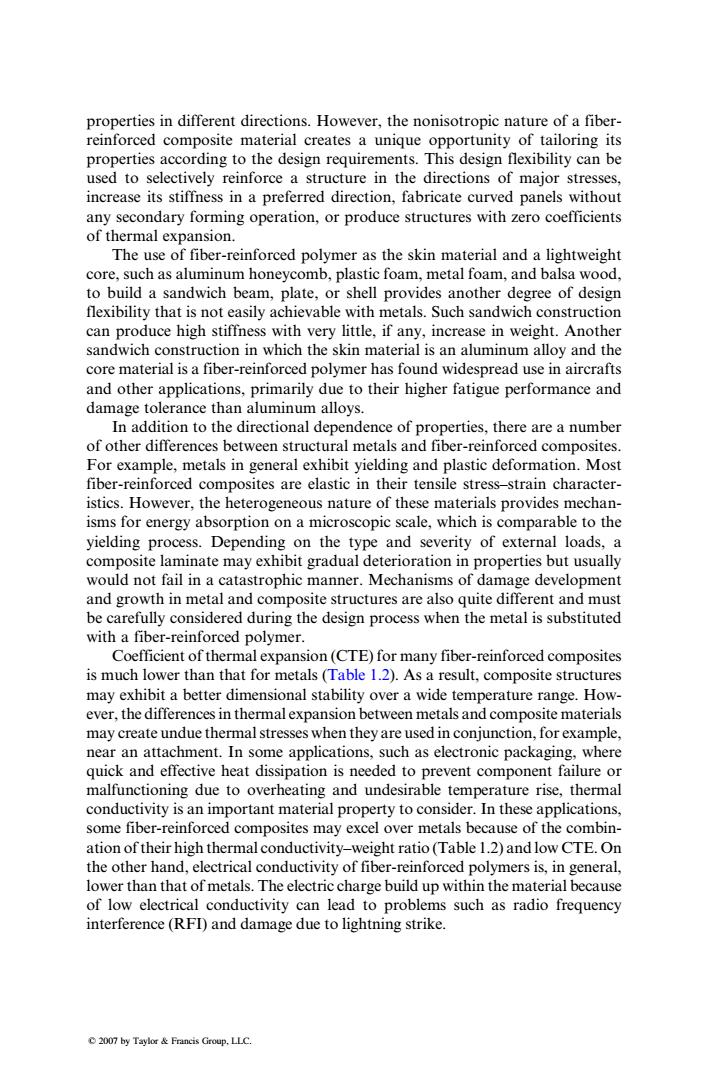正在加载图片...

properties in different directions.However,the nonisotropic nature of a fiber- reinforced composite material creates a unique opportunity of tailoring its properties according to the design requirements.This design flexibility can be used to selectively reinforce a structure in the directions of major stresses, increase its stiffness in a preferred direction,fabricate curved panels without any secondary forming operation,or produce structures with zero coefficients of thermal expansion. The use of fiber-reinforced polymer as the skin material and a lightweight core,such as aluminum honeycomb,plastic foam,metal foam,and balsa wood, to build a sandwich beam,plate,or shell provides another degree of design flexibility that is not easily achievable with metals.Such sandwich construction can produce high stiffness with very little,if any,increase in weight.Another sandwich construction in which the skin material is an aluminum alloy and the core material is a fiber-reinforced polymer has found widespread use in aircrafts and other applications,primarily due to their higher fatigue performance and damage tolerance than aluminum alloys. In addition to the directional dependence of properties,there are a number of other differences between structural metals and fiber-reinforced composites. For example,metals in general exhibit yielding and plastic deformation.Most fiber-reinforced composites are elastic in their tensile stress-strain character- istics.However,the heterogeneous nature of these materials provides mechan- isms for energy absorption on a microscopic scale,which is comparable to the yielding process.Depending on the type and severity of external loads,a composite laminate may exhibit gradual deterioration in properties but usually would not fail in a catastrophic manner.Mechanisms of damage development and growth in metal and composite structures are also quite different and must be carefully considered during the design process when the metal is substituted with a fiber-reinforced polymer. Coefficient of thermal expansion(CTE)for many fiber-reinforced composites is much lower than that for metals (Table 1.2).As a result,composite structures may exhibit a better dimensional stability over a wide temperature range.How- ever,the differences in thermal expansion between metals and composite materials may create undue thermal stresses when they are used in conjunction,for example, near an attachment.In some applications,such as electronic packaging,where quick and effective heat dissipation is needed to prevent component failure or malfunctioning due to overheating and undesirable temperature rise,thermal conductivity is an important material property to consider.In these applications, some fiber-reinforced composites may excel over metals because of the combin- ation of their high thermal conductivity-weight ratio (Table 1.2)and low CTE.On the other hand,electrical conductivity of fiber-reinforced polymers is,in general, lower than that of metals.The electric charge build up within the material because of low electrical conductivity can lead to problems such as radio frequency interference(RFD)and damage due to lightning strike. 2007 by Taylor Francis Group,LLC.properties in different directions. However, the nonisotropic nature of a fiberreinforced composite material creates a unique opportunity of tailoring its properties according to the design requirements. This design flexibility can be used to selectively reinforce a structure in the directions of major stresses, increase its stiffness in a preferred direction, fabricate curved panels without any secondary forming operation, or produce structures with zero coefficients of thermal expansion. The use of fiber-reinforced polymer as the skin material and a lightweight core, such as aluminum honeycomb, plastic foam, metal foam, and balsa wood, to build a sandwich beam, plate, or shell provides another degree of design flexibility that is not easily achievable with metals. Such sandwich construction can produce high stiffness with very little, if any, increase in weight. Another sandwich construction in which the skin material is an aluminum alloy and the core material is a fiber-reinforced polymer has found widespread use in aircrafts and other applications, primarily due to their higher fatigue performance and damage tolerance than aluminum alloys. In addition to the directional dependence of properties, there are a number of other differences between structural metals and fiber-reinforced composites. For example, metals in general exhibit yielding and plastic deformation. Most fiber-reinforced composites are elastic in their tensile stress–strain characteristics. However, the heterogeneous nature of these materials provides mechanisms for energy absorption on a microscopic scale, which is comparable to the yielding process. Depending on the type and severity of external loads, a composite laminate may exhibit gradual deterioration in properties but usually would not fail in a catastrophic manner. Mechanisms of damage development and growth in metal and composite structures are also quite different and must be carefully considered during the design process when the metal is substituted with a fiber-reinforced polymer. Coefficient of thermal expansion (CTE) for many fiber-reinforced composites is much lower than that for metals (Table 1.2). As a result, composite structures may exhibit a better dimensional stability over a wide temperature range. However, the differences in thermal expansion between metals and composite materials may create undue thermal stresses when they are used in conjunction, for example, near an attachment. In some applications, such as electronic packaging, where quick and effective heat dissipation is needed to prevent component failure or malfunctioning due to overheating and undesirable temperature rise, thermal conductivity is an important material property to consider. In these applications, some fiber-reinforced composites may excel over metals because of the combination of their high thermal conductivity–weight ratio (Table 1.2) and low CTE. On the other hand, electrical conductivity of fiber-reinforced polymers is, in general, lower than that of metals. The electric charge build up within the material because of low electrical conductivity can lead to problems such as radio frequency interference (RFI) and damage due to lightning strike. 2007 by Taylor & Francis Group, LLC